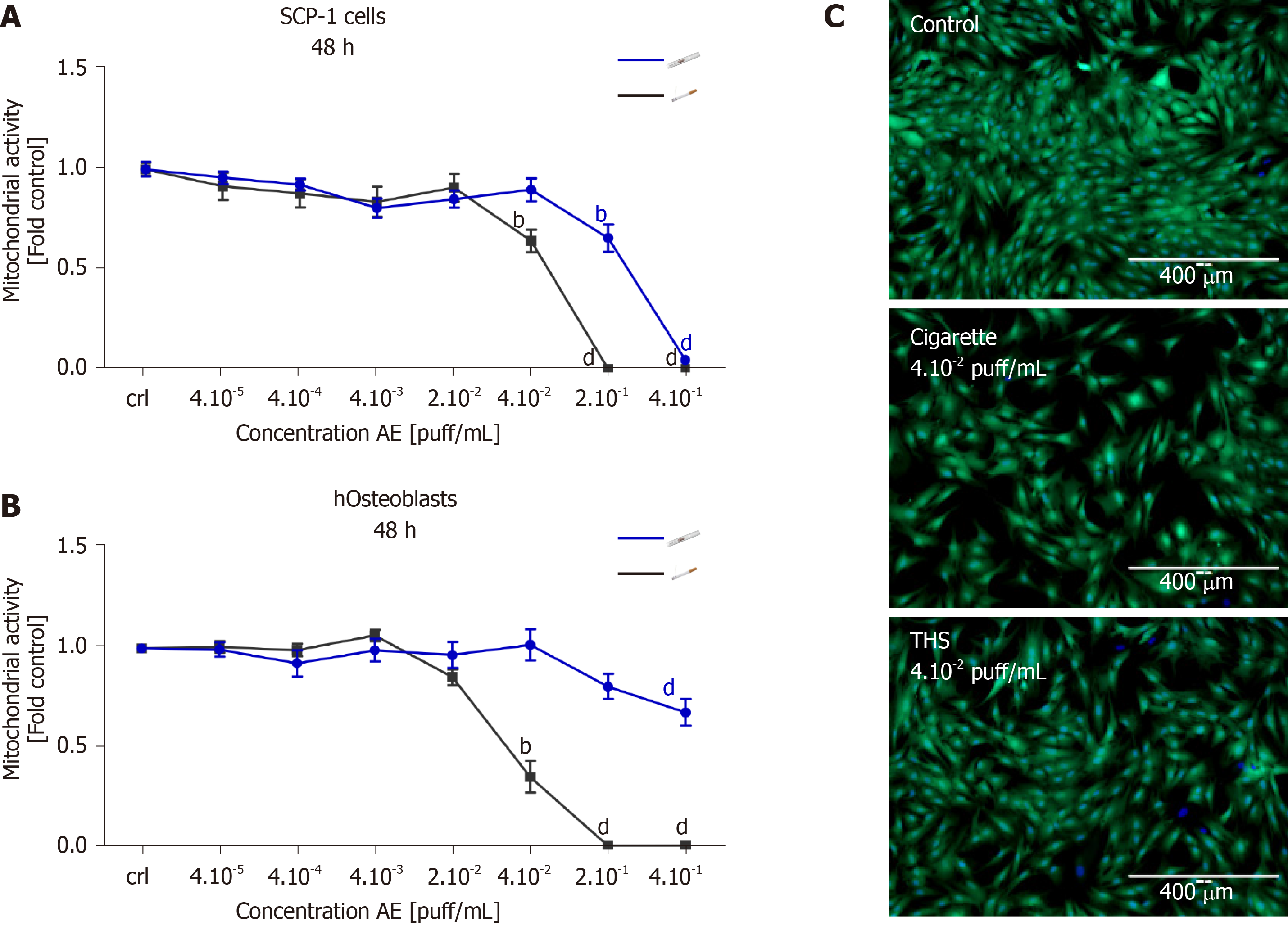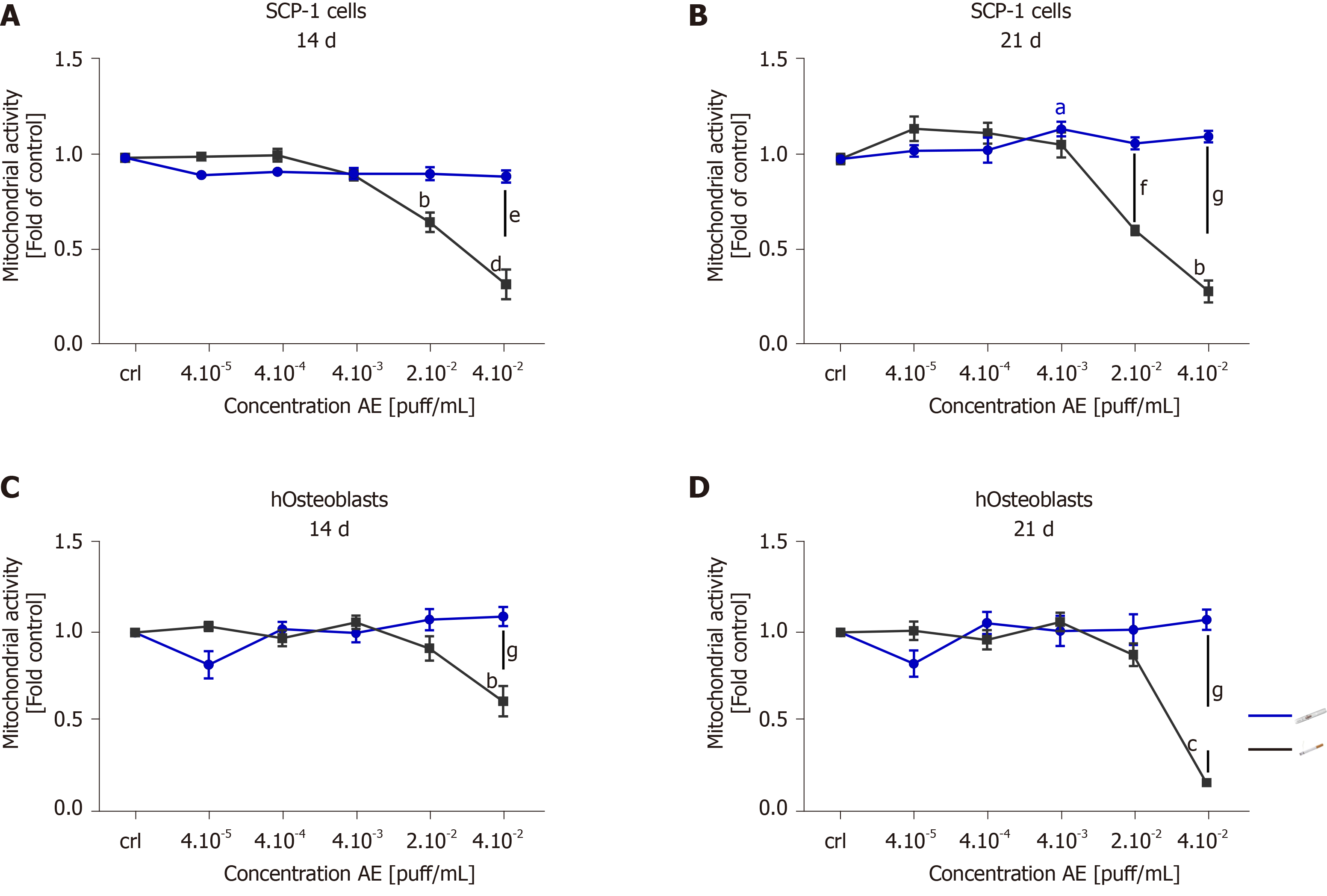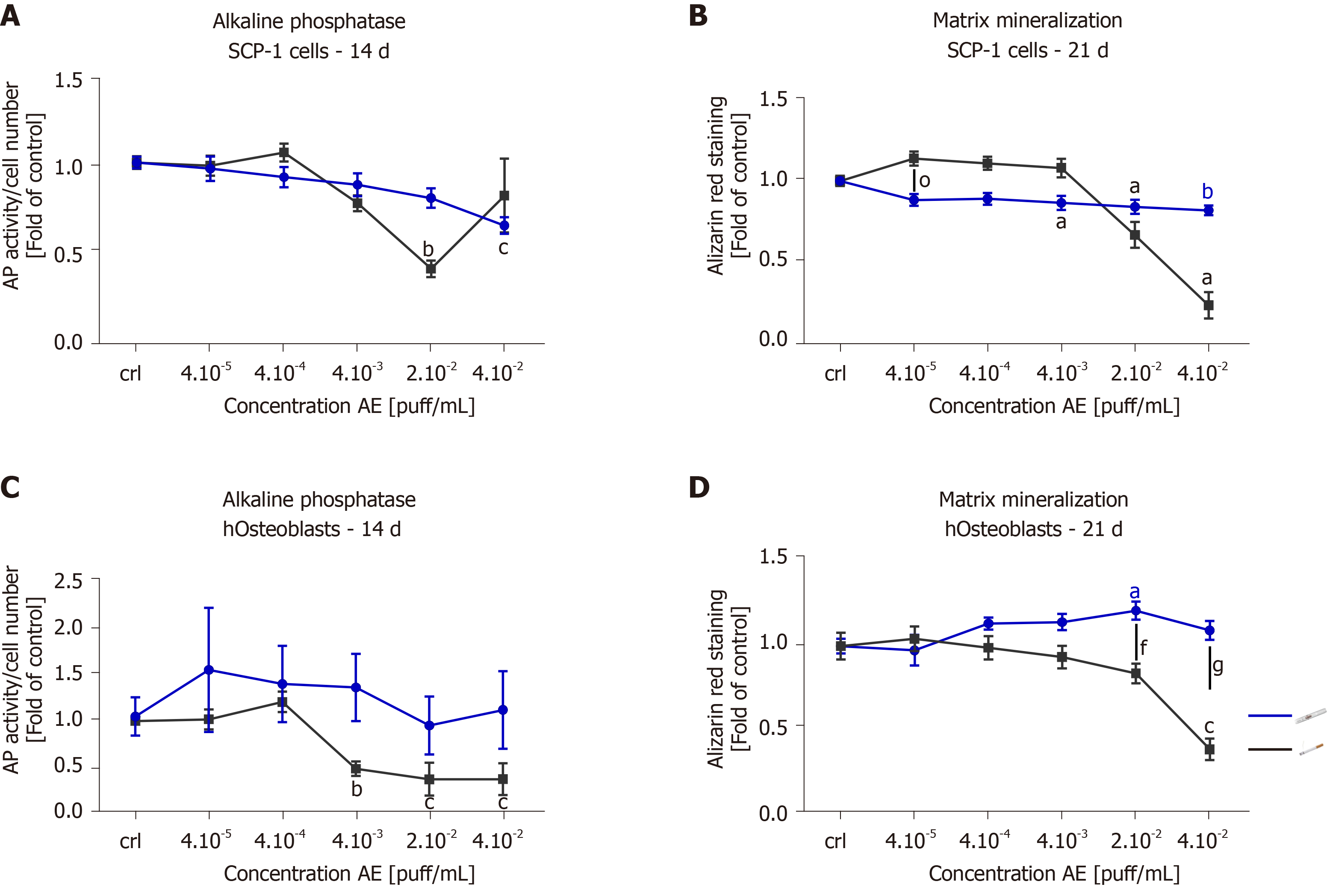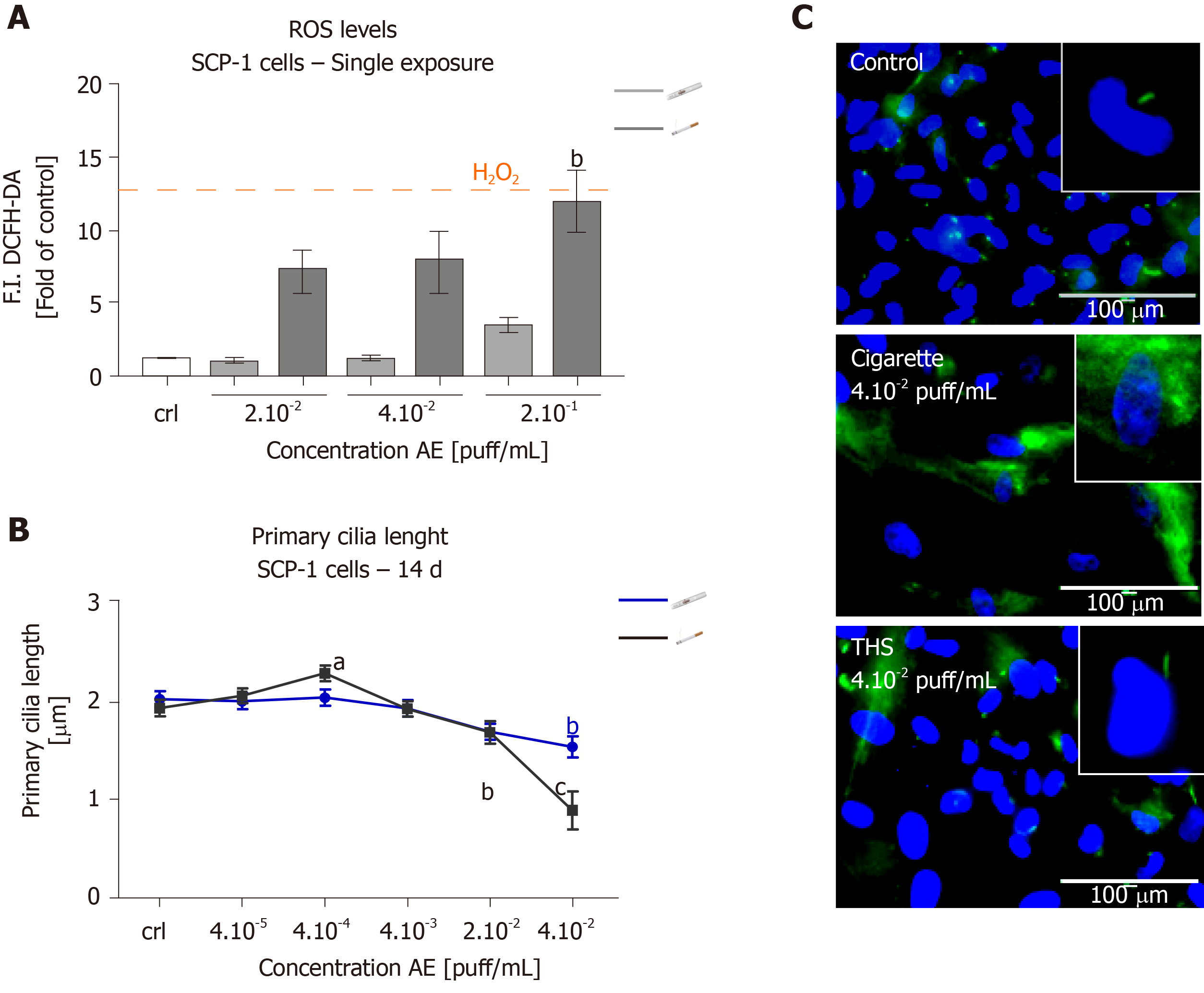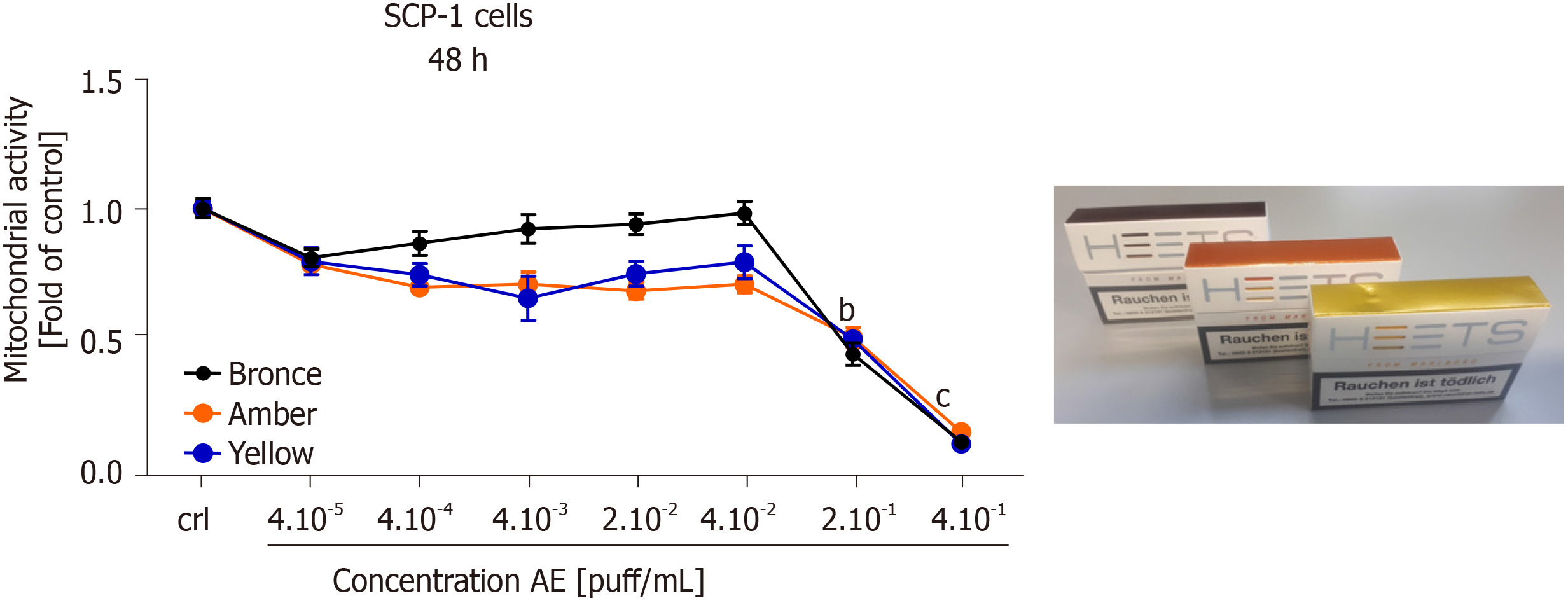Copyright
©The Author(s) 2020.
World J Stem Cells. Aug 26, 2020; 12(8): 841-856
Published online Aug 26, 2020. doi: 10.4252/wjsc.v12.i8.841
Published online Aug 26, 2020. doi: 10.4252/wjsc.v12.i8.841
Figure 1 Tobacco heating systems and conventional cigarette aqueous extract characterization.
A: Time to consume one unit [cigarette or tobacco heating systems (THS) stick] measured in minutes; B: pH from the aqueous extract (AE) generated with conventional cigarettes or THS; C: Absorbance at 320 nm from the different fractions produced from conventional cigarette or THS; D: Representative picture of gas washing bottle after conventional cigarette or THS AE generation, respectively. Each measure was conducted with six independent AE for each condition in triplicates. Data were analyzed using the nonparametric Mann Whitney test or the Kruskal-Wallis H test followed by Dunn’s post-hoc tests. Data are presented as mean ± SE, and P < 0.001 for the comparison. THS: Tobacco heating systems.
Figure 2 High concentrations of aqueous extract from tobacco heating systems has minor effects on bone cells viability after a single exposure than aqueous extract from conventional cigarettes.
SCP-1 cells and primary human osteoblasts were treated with increasing concentrations of aqueous extract (AE) from conventional cigarettes and tobacco heating systems. Cell viability was evaluated by resazurin conversion (mitochondrial activity) in SCP-1 cells (A) and primary osteoblast (B) after 48 h of treatment; C: Representative live staining pictures from SCP-1 cells using calcein-AM (green) and nuclear staining using Hoechst 33342 (blue) was shown after 48 h of exposure to AE (scale bar 400 µm). Each measure was conducted at least three independent times in triplicates. Data were analyzed using the Kruskal-Wallis H test followed by Dunn’s post-hoc tests. Data are presented as mean ± SE, and P values indicated as bP < 0.01 and dP < 0.001 for comparisons with untreated cells within the same AE type. AE: Aqueous extract.
Figure 3 Tobacco heating systems is less toxic than conventional cigarettes after chronic exposure.
SCP-1 cells and primary human osteoblasts were osteogenically differentiated with increasing concentrations of aqueous extract (AE) from conventional cigarette and tobacco heating systems (THS) for 21 d. Cell viability was evaluated by resazurin conversion (mitochondrial activity) in SCP-1 cells (A, B) and primary human osteoblast (C, D) after 14 (A, C) and 21 d (B, D). Each measurement was conducted at least three independent times in triplicates. Data were analyzed using the Kruskal-Wallis H test followed by Dunn’s post-hoc test. Data are presented as mean ± SE. P values are classified as aP < 0.05, bP < 0.01, cP < 0.001 for comparisons with untreated cells within AE type and as eP < 0.05, fP < 0.01, gP < 0.001 for comparisons of conventional cigarette with THS within the same concentration. AE: Aqueous extract.
Figure 4 Tobacco heating systems has a lower impact on bone cells function than conventional cigarettes.
SCP-1 cells and primary human osteoblasts were osteogenically differentiated with increasing concentrations of aqueous extract (AE) from conventional cigarettes and tobacco heating systems (THS) for 21 d. Cell function was evaluated by alkaline phosphatase activity (early differentiation marker) (A, C) after 14 d. Calcium deposition (late marker of differentiation) was evaluated by Alizarin red staining (B, D) after 21 d (B, D). Each measurement was conducted at least three independent times in triplicates. Data were analyzed using the Kruskal-Wallis H test followed by Dunn’s post-hoc test. Data are represented as mean ± SE, and P values are classified as aP < 0.05, bP < 0.01, cP < 0.001 for comparisons with untreated cells within the same AE type and fP < 0.01, gP < 0.001 for comparisons conventional cigarette with THS within the same concentration. AE: Aqueous extract.
Figure 5 Tobacco heating systems induces less oxidative stress and causes less damage to primary cilia structures on bone cells precursor than conventional cigarettes.
SCP-1 cells were treated with increasing concentrations of aqueous extract (AE) from conventional cigarettes and tobacco heating systems (THS). ROS production was evaluated by DCFH-DA assay in SCP-1 cells. 0.01%v/v H2O2 was used as a positive control (A). Primary cilium length was quantified on day 14 by acetylated α-tubulin (green), and nuclei (blue) immunostaining (B). Representative immunostaining images of SCP-1 cells primary cilia after 14 days of chronic exposure to THS or conventional cigarettes AE (C) (scale bar 100 µm). Each measurement was conducted at least three independent times in triplicates. Data were analyzed using the Kruskal-Wallis H test followed by Dunn’s post-hoc tests. Data are represented as mean ± SE, and P values are classified as aP < 0.05, bP < 0.01, cP < 0.001 for comparisons with untreated cells within AE type. AE: Aqueous extract.
Figure 6 No differential variation in cytotoxicity between different tobacco heating systems flavors on bone cells precursor.
SCP-1 cells were treated with increasing concentrations of aqueous extract (AE) from tobacco heating systems bronce, amber and yellow flavor. Cell cytotoxicity was evaluated by resazurin conversion (mitochondrial activity) in SCP-1 cells after 48 h of exposure. Each measurement was conducted at least three independent times in triplicates. Data were analyzed using the Kruskal-Wallis H test followed by Dunn’s post-hoc tests. Data are presented as mean ± SE, and P values are classified as bP < 0.01, cP < 0.001 for comparisons with untreated cells within AE type. AE: Aqueous extract.
- Citation: Aspera-Werz RH, Ehnert S, Müller M, Zhu S, Chen T, Weng W, Jacoby J, Nussler AK. Assessment of tobacco heating system 2.4 on osteogenic differentiation of mesenchymal stem cells and primary human osteoblasts compared to conventional cigarettes. World J Stem Cells 2020; 12(8): 841-856
- URL: https://www.wjgnet.com/1948-0210/full/v12/i8/841.htm
- DOI: https://dx.doi.org/10.4252/wjsc.v12.i8.841










